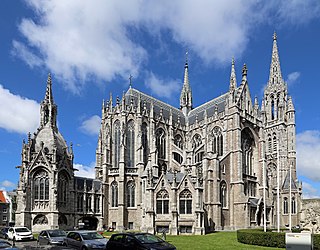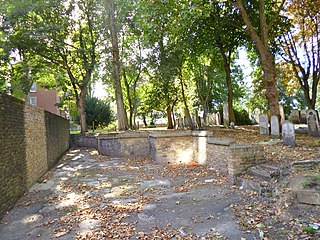Related Research Articles

Sir Nikolaus Bernhard Leon Pevsner was a German-British art historian and architectural historian best known for his monumental 46-volume series of county-by-county guides, The Buildings of England (1951–74).

Gothic Revival is an architectural movement that began in the late 1740s in England. Its momentum grew in the early 19th century, when increasingly serious and learned admirers of neo-Gothic styles sought to revive medieval Gothic architecture, in contrast to the neoclassical styles prevalent at the time. Gothic Revival draws features from the original Gothic style, including decorative patterns, finials, lancet windows, hood moulds and label stops. By the mid-19th century, it was established as the preeminent architectural style in the Western world.

Eythrope is a hamlet and country house in the parish of Waddesdon, in Buckinghamshire, England. It is located to the south east of the main village of Waddesdon. It was bought in the 1870s by a branch of the Rothschild family, and belongs to them to this day.

Sir Arthur William Blomfield was an English architect. He became president of the Architectural Association in 1861; a Fellow of the Royal Institute of British Architects in 1867 and vice-president of the RIBA in 1886. He was educated at Trinity College, Cambridge, where he read Architecture.

The Willesden United Synagogue Cemetery, usually known as Willesden Jewish Cemetery, is a cemetery for Jews at Beaconsfield Road, Willesden, in the London Borough of Brent, England. It opened in 1873 on a 20-acre (0.08 km2) site. It has been described as the "Rolls Royce" of London's Jewish cemeteries and is designated Grade II on Historic England's Register of Historic Parks and Gardens. The cemetery, which has 29,800 graves, has many significant memorials and monuments. Four of them are listed at Grade II. They include the tomb of Rosalind Franklin, who was a co-discoverer of the structure of DNA.

Sir Matthew Digby Wyatt was a British architect and art historian who became Secretary of the Great Exhibition, Surveyor of the East India Company and the first Slade Professor of Fine Art at the University of Cambridge. From 1855 until 1859 he was honorary secretary of the Royal Institute of British Architects, and in 1866 received the Royal Gold Medal.

Evelina Gertrude de Rothschild was an English socialite and a member of the Rothschild banking family of England.

William Henry Bidlake MA, FRIBA was an English architect, a leading figure of the Arts and Crafts movement in Birmingham and Director of the School of Architecture at Birmingham School of Art from 1919 until 1924.

Little Germany, Bradford, is an area of particular historical and architectural interest in central Bradford, West Yorkshire, England. The architecture is predominantly neoclassical in style with an Italian influence. Many individual buildings are listed, and Little Germany is also protected as a Conservation Area.
Charles Francis Hansom was a prominent Roman Catholic Victorian architect who primarily designed in the Gothic Revival style.

The Cheltenham Synagogue is a synagogue in Cheltenham noted for its Regency architecture. It is an independent congregation located in the town centre on Synagogue Lane, off St James's Square.
West Ham Jewish Cemetery is a cemetery for Jews in West Ham in the London Borough of Newham, England. It was established in 1856 by the New Synagogue on Great St. Helen's, soon joined by the Great Synagogue in Duke's Place, both of them London congregations.

The Peacock Mausoleum is a Victorian Gothic memorial to Richard Peacock (1820–1889), engineer and Liberal MP for Manchester, and to his son, Joseph Peacock. It is situated in the cemetery of Brookfield Unitarian Church, Gorton, Manchester. The mausoleum was designed by the prolific Manchester architect Thomas Worthington. It was listed Grade II* on the National Heritage List for England on 3 October 1974.

Brookfield Unitarian Church, Gorton, Manchester, is a Victorian Gothic church.

St Mary Magdalen Roman Catholic Church, Mortlake is a Roman Catholic church in North Worple Way, Mortlake, in the London Borough of Richmond upon Thames. Its priest is Canon Francis Moran.

The Church of St Mary and St Thomas is one of two Anglican churches in Knebworth, Hertfordshire, England. The church dates from the twelfth century and is a grade I listed building.

The Brady Street Cemetery is a disused Jewish cemetery on Brady Street in Whitechapel in the East End of London, E1. The cemetery opened in 1761 as the burial ground for the New Synagogue and was subsequently used by the Great Synagogue. It closed in 1857. Several notable people are buried there.

The Tomb of Karl Marx stands in the Eastern cemetery of Highgate Cemetery, North London, England. It commemorates the burial sites of Marx, of his wife, Jenny von Westphalen, and other members of his family. Originally buried in a different part of the Eastern cemetery, the bodies were disinterred and reburied at their present location in 1954. The tomb was designed by Laurence Bradshaw and was unveiled in 1956, in a ceremony led by Harry Pollitt, the General Secretary of the Communist Party of Great Britain, which funded the memorial. The tomb consists of a large bust of Marx in bronze set on a marble pedestal. The pedestal is inscribed with quotes from Marx's works including, on the front, the final words of The Communist Manifesto, "Workers of all lands unite". Since its construction, the tomb has become a place of pilgrimage for followers of Marxist theory. It has also been a target for Marx's opponents, suffering vandalism, and two bomb attacks in the 1970s. It is a Grade I listed structure, the highest listing reserved for buildings and structures of "exceptional interest".
References
- ↑ Defaced, the Rothschild mausoleum that has stood for 140 years By Louis Jebb, The Independent , 16 June, 205
- ↑ Sharman Kadish, Jewish Heritage in England : An Architectural Guide, English Heritage, 2006, p. 35
- ↑ "Mausoleums", Lynn F. Pearson, Osprey Publishing, 2001, p. 21
- ↑ "Studies in Art, Architecture, and Design": Victorian and after, Nikolaus Pevsner, Walker, 1908, v. 2, p. 101
- ↑ "The shocking face of anti-Semitism at a West Ham cemetery yesterday: the 117th attack on a Jewish graveyard in 15 years", Marie Woolf, The Independent , 16 June 2005
- ↑ "Defaced, the Rothschild mausoleum that has stood for 140 years". Archived from the original on September 23, 2009. Retrieved 2009-07-01.CS1 maint: bot: original URL status unknown (link). Louis Jebb, The Independent , 16 June 2005.
| | This article about a cemetery in the United Kingdom is a stub. You can help Wikipedia by expanding it. |
| | This article about a Jewish cemetery is a stub. You can help Wikipedia by expanding it. |